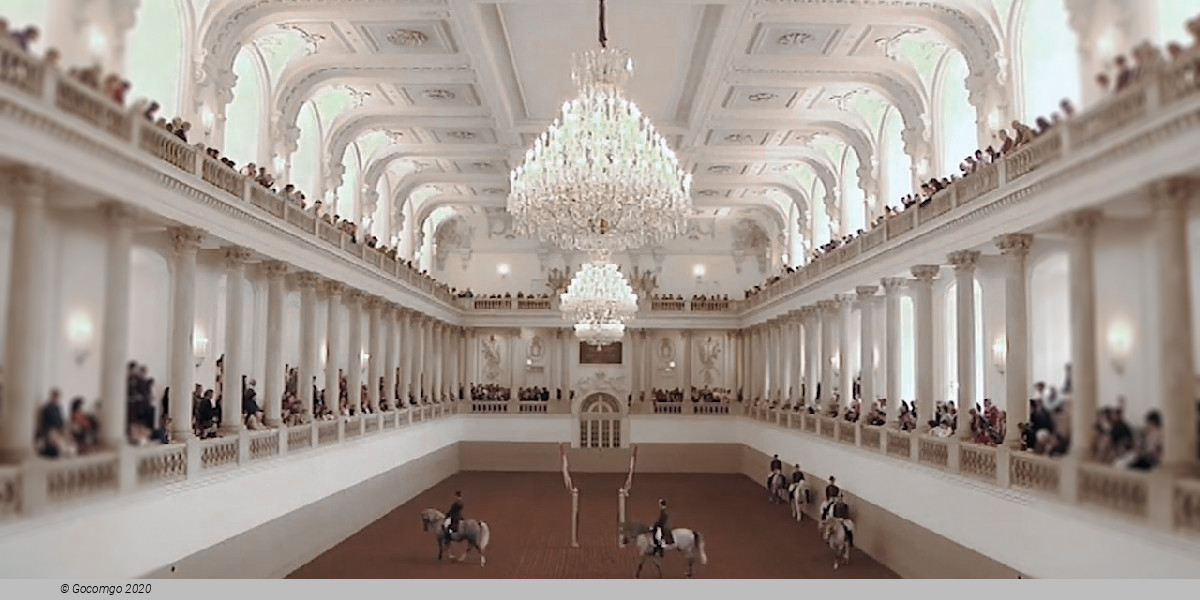Spanish Riding School (Vienna, Austria)
Spanish Riding School

The Spanish Riding School (Spanische Hofreitschule) is an Austrian institution dedicated to the preservation of classical dressage and the training of Lipizzaner horses, based in Vienna, Austria, whose performances in the Hofburg are also a tourist attraction.
The leading horses and riders of the school also periodically tour and perform worldwide. It is one of the "Big Four", the most prestigious classical riding academies in the world, alongside the Cadre Noir, the Portuguese School of Equestrian Art, and the Royal Andalusian School.
The riding school was first named during the Habsburg Monarchy in 1572, long before the French manege of Antoine de Pluvinel, and is the oldest of its kind in the world. Records show that a wooden riding arena was first commissioned in 1565, but it wasn't until 1729 that Emperor Charles VI commissioned the architect Joseph Emanuel Fischer von Erlach to build the white riding hall used today. Prior to that time, the school operated from a wooden arena at the Josefsplatz. For a time, the riding hall was used for various ceremonies, but it is now open to the public, who may witness the training and performances by the stallions.
The Spanish Riding School was named for the Spanish horses that formed one of the bases of the Lipizzan breed, which is used exclusively at the school. Today the horses delivered to the Spanish Riding School are bred at the Piber Federal Stud located near the village of Piber in western Styria, Austria. One of the original studs used to develop the breed was Lipizza, now called Lipica, near Trieste in modern Slovenia, which gave its name to the breed.
The Spanish Riding School has antecedents in military traditions dating as far back as Xenophon in Ancient Greece, and particularly from the military horsemanship of the post-medieval ages when knights attempted to retain their battlefield preeminence by shedding heavy armor and learning to maneuver quickly and with great complexity on a firearms-dominated battlefield.
Traditionally, Lipizzaners at the school have been trained and ridden wholly by men, although the Spanish Riding School states that there has never been an official ban on women. In October 2008, two women, Sojourner Morrell, 18-year-old from the United Kingdom and Hannah Zeitlhofer, 21-year-old from Austria, passed the entrance exam and were accepted to train as riders at the school - the first women to do so in 436 years.
Performances
Performances at the Spanish Riding School were originally only presented to guests of the Court, and then when they were finally opened to the general population at the turn of the century, it was only for special occasions. However, after the fall of the Austro-Hungarian empire in 1918, the school opened up regular performances to the general public to help pay for its upkeep.
The original performances were quite short, with the chief riders presenting stallions in the High School movements, airs above the ground, work in-hand and exercises on the long rein, and then a Pas de Deux (two horses in mirror image) and a four-rider Quadrille would finish the performance.
The program today has expanded. It begins with the "Young Stallions" which have recently arrived from the stud farm at Piber. They demonstrate the first phase of training, in which the horse moves forward and accepts the aids. The next section is the "All Steps and Movements of the High School" where four fully trained stallions perform each of the movements seen in the Olympic Grand Prix Dressage test, including the flying change, passage, pirouette, and piaffe. The horses are ridden in double bridle, to demonstrate their high level of training. The "Pas De Deux" is then shown, with two horses demonstrating High School movements in mirror image.
The next section is the "Work in Hand", to show how the horses are trained for the school jumps levade, capriole, and courbette, all in-hand. This demonstration includes work on the diagonal, on the wall and between the pillars. All stallions wear a snaffle bridle, cavesson, side reins, some on short hand rein, some with a short longe. All carry the traditional white saddle of the school. Then one stallion is then worked "On the Long Rein", in which a fully trained Lipizzan performs all the movements it would be asked to do under saddle. In this section, the horse wears a red snaffle bridle and a red shabrack (saddlecloth) with the golden coat of arms of the Austrian Empire.
The "Airs Above the Ground" follows; all horses are under saddle, but the riders do not have stirrups. Movements performed include the levade, capriole and courbette. The performance finishes with the "School Quadrille", consisting of 8 riders working in formation at the walk, trot, and canter, with flying changes, pirouettes, the half pass and the passage. The ride is performed to classical music. Lasting 20 minutes, the School Quadrille of the Spanish Riding School is the longest and most difficult in the world.


